Prof. Dr. Mamdouh Al-Damati reveals the story of Zafaran Palace
Prof. Dr. Mamdouh Al-Damati, Professor of Egyptology and former Minister of Antiquities and Dean of the Faculty of Archeology confirmed that the story of the Zafaran Palace was marred by a lot of misinformation. This came during his speech delivered at the opening session of the ninth scientific conference of Ain Shams University, where he presented his book (The Zafaran Palace is a fragrant history and exploring the future) In which he told the story of the Zafaran Palace and Ain Shams University.
He explained that the story of the palace began since the establishment of the Abbasid neighborhood, where Khedive Abbas Helmy encouraged princes and sons of women to build in Haswa (Abbasid, which was called Abbasid in 1850), and he also built a luxurious palace consisting of five Sarathas, which was bought by Khedive Ismail. Dr. Mamdouh Al-Damati said that Khedive Ismail had gifted his mother Khoshyar Hanim Al Jabal Palace, which became known as (Al Saraya Al Safra) in addition to three of the five companies, indicating that in 1869 the Zafaran Palace was built for the mother Pasha (Khoshyar Hanim, the mother of Khedive Ismail) and it was removed in the year 1869. 1900, explaining that the current palace was built in 1901 by the engineer, Antonio Lachiak, an Italian engineer of Austrian origin, at the request of my wife, Khedive Ismail, after his departure.
His Excellency also reviewed the beauty aspects in the construction of the Zafaran Palace represented in various arts such as Baroque, Rococo, and modern art in the use of metals.
As explained by Prof. Dr. Mamdouh Al-Damati, stages of development of the palace, where it was used as a guesthouse for the residence of kings and princes, the guests and chief visitors of Egypt, such as King Abdul Aziz Al Saud, King Albert of Belgium, as well as the important events that took place in the palace, where a Khedive school was established next to it, then it was converted as the headquarters of the National University in 1920 through political and historical events, where the palace witnessed the initial signing of the 1936 Treaty, the signing of the Arab League Charter in 1945, and the palace witnessed many conferences.
Until it became the headquarters of Ibrahim Pasha University in 1950 before the name changed to Heliopolis University and then Ain Shams University.

.svg)




